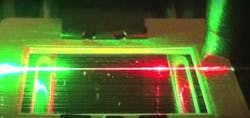(Image: EPFL) Fiber-optics specialists at École polytechnique fédérale de Lausanne (EPFL; Switzerland) are using strands of spider silk as optical fibers that react in interesting ways to chemical contact, serving as optical molecular sensors. Picking up on an idea proposed by a discussion group of the European Space Agency, Luc Thévenaz, the professor in charge of EPFL's Group for Fibre Optics, shifted his attention away from traditional fibers made of glass and focused on the spider silk. These strands are perfectly cylindrical, smooth, transparent and extremely solid -- some of the same characteristics as glass-based fibers. But while glass is inert, spider silk is made up of very long proteins rolled into a helix structure whose bonds are sensitive to a number of chemical substances.Reusable chemical sensors "The helix in the silk strands unwinds whenever polar molecules like acetic acid and ammonia come into contact with its bonds," says Thévenaz. "This measurably modifies the way the strands conduct light, and it gave us the idea of using them to make chemical sensors." The researchers also discovered that the change in the helix structure was reversible; a sensor using spider silk could thus be used several times over. "We are looking at the possibility of creating silks by adding molecules meant to react with the substances to be tested," says Thévenaz. "That is often impossible with glass fibers, which we have to heat to more than 1000°C in order to stretch." At EPFL, doctoral student Desmond Chow and post-doc Kenny Hey Tow are working on natural silk strands with a diameter of 5 μm. They were produced by Australian Nephila edulis spiders grown at the Department of Zoology of the University of Oxford. Synthetic silks exist, but they are expensive and do not work as well as real ones.
(Video: EPFL) The researchers stretch a silk strand taut in a bracket and direct a laser beam at one end of the strand. At the other end, a polarization analyzer is used to measure small changes in the light passing through it. If a gas that interacts with the silk strand is present, the device will pick up on this. Because silk is biodegradable, it is ideal for sensors that could be implanted in a living body without needing to be removed later on. Source: http://actu.epfl.ch/news/using-spider-silk-to-detect-molecules/
Sponsored Recommendations
Sponsored Recommendations
March 31, 2025
March 31, 2025
March 31, 2025
Voice your opinion!
Voice your opinion!
